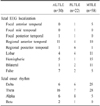1. Pacia SV, Devinsky O, Perrine K, Ravdin L, Luciano D, Vazquez B, et al. Clinical features of neocortical temporal lobe epilepsy. Ann Neurol. 1996. 40:724–730.
2. O'Brien TJ, Kilpatrick C, Murrie V, Vogrin S, Morris K, Cook MJ. Temporal lobe epilepsy caused by mesial temporal sclerosis and temporal neocortical lesions. A clinical and electroencephalographic study of 46 pathologically proven cases. Brain. 1996. 119:2133–2141.
3. Gil-Nagel A, Risinger MW. Ictal semiology in hippocampal versus extrahippocampal temporal lobe epilepsy. Brain. 1997. 120:183–192.

4. Foldvary N, Lee N, Thwaites G, Mascha E, Hammel J, Kim H, et al. Clinical and electrographic manifestation of lesional neocortical temporal lobe epilepsy. Neurology. 1997. 49:757–763.

5. Saygi S, Spencer SS, Scheyer R, Katz A, Mattson R, Spencer DD. Differentiation of temporal lobe ictal behavior associated with hippocampal sclerosis and tumors of temporal lobe. Epilepsia. 1994. 35:737–742.

6. Burgerman RS, Sperling MR, French JA, Saykin AJ, O'Connor MJ. Comparison of mesial versus neocortical onset temporal lobe seizures: neurodiagnostic findings and surgical outcome. Epilepsia. 1995. 36:662–670.

7. Engel J Jr, Van Ness PC, Rassmussen TB, Ojemann LM. Engel J, editor. Outcome with respect to epileptic seizures. Surgical treatment of epilepsies. 1993. New York: Raven Press;609–691.
8. Lee SK, Kim JY, Hong KS, Nam HW, Park SH, Chung CK. The clinical usefulness of ictal surface EEG in neocortical epilepsy. Epilepsia. 2000. 41:1450–1455.

9. Sperling MR, Cahan LD, Brown WJ. Relief of seizures from a predominantly posterior temporal tumor with anterior temporal lobectomy. Epilepsia. 1989. 30:559–563.

10. Olivier A, Gloor P, Andermann F, Ives J. Occipitotemporal epilepsy studied with stereotaxically implanted depth electrodes and successfully treated by temporal resection. Ann Neurol. 1982. 11:428–432.

11. Rasmussen TB. Surgical treatment of complex partial seizures: results, lessons, and problems. Epilepsia. 1983. 24:S65–S76.

12. Ebner A. Wolf P, editor. Lateral (neocortical) temporal lobe epilepsy. Epileptic seizures and syndromes. 1997. London: John Libbey;375–382.
13. Williamson PD, Wieser HG, Delgado-Escueta AV. Engel J Jr. Clinical characteristics of partial seizures. Surgical treatment of epilepsies. 1987. New York: Raven Press;101–120.
14. Penfield W, Perot P. The brain's record of auditory and visual experience. A final summary and discussion. Brain. 1963. 86:595–696.

15. Liegeois-Chauvel C, Musolino A, Chauvel P. Localization of the primary auditory area in man. Brain. 1991. 114:139–151.
16. Schneider RC, Calhoun HD, Crosby EC. Vertigo and rotational movement in cortical and subcortical lesions. J Neurol Sci. 1968. 6:493–516.

17. Penfield W. The twenty-ninth Maudsley lecture: the role of the temporal cortex in certain psychical phenomena. J Ment Sci. 1955. 101:451–465.

18. Gloor P, Olivier A, Quesney LF, Andermann A, Horowitz S. The role of the limbic system in experiential phenomena of temporal lobe epilepsy. Ann Neurol. 1982. 12:129–144.

19. Mihara T, Inoue Y, Hiyoshi T, Watanabe Y, Kubota Y, Tottori T, et al. Localizing value of seizure manifestations of temporal lobe epilepsies and the consequence of analyzing their sequential appearance. Jpn J Psychiatry Neurol. 1993. 47:175–182.

20. Lieb JP, Engel J Jr, Babb TL. Interhemispheric propagation time of human hippocampal seizures I Relationship to surgical outcome. Epilepsia. 1986. 27:286–293.

21. Duchowny M, Jayakar P, Resnick T, Levin B, Alvarez L. Posterior temporal epilepsy: electroclinical features. Ann Neurol. 1994. 35:427–431.

22. Ebersole JS, Pacia SV. Localization of temporal lobe foci by ictal EEG patterns. Epilepsia. 1996. 37:386–399.

23. Foldvary N, Klem G, Hammel J, Bingaman W, Najm I, Luders H. The localizing value of ictal EEG in focal epilepsy. Neurology. 2001. 57:2022–2028.





 PDF
PDF ePub
ePub Citation
Citation Print
Print









 XML Download
XML Download